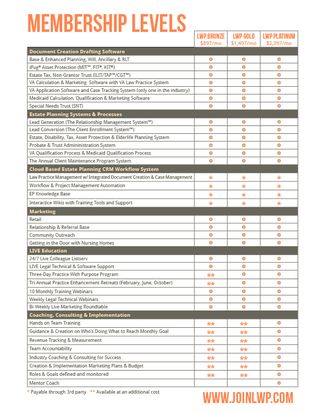Real quick, I’m not certain if you saw my two other previous blog posts and I wanted to make sure I kept you in the loop. I KNOW how Monday mornings feel with the email barrage…especially after being away from the computer all weekend (hopefully).
 I wanted to make sure you were aware LWP announced it has made a few changes to our membership levels specifically designed to serve solo and small sized firms based on their customized needs.
I wanted to make sure you were aware LWP announced it has made a few changes to our membership levels specifically designed to serve solo and small sized firms based on their customized needs.
WHAT is changing you ask? Here are a few of the CHANGES in the membership levels.
- LWP Silver Membership: This level of membership is currently $897/month which INCLUDES our 3 Day Technical/Legal training as well as the 3 hour VA accreditation program. Effective tomorrow this LIVE educational training program is no longer included in this level of membership. The tuition to attend this program will be an additional fee of $1,497 (A $1,497 SAVINGS if you enroll TODAY).
- LWP Gold Membership: This level of membership is currently $1,497/month which INCLUDES everything that the SILVER Level of membership offers PLUS the hands on customized, personalized Coaching, Consulting & Implementation program for your entire Law Firm. Effective tomorrow the Coaching, Consulting and Implementation is no longer included in this level of membership. (A $997/a month SAVINGS if you enroll TODAY).
- LWP PLATINUM Membership: NEW Additional LEVEL. This level of membership was never previously offered. It is $2,397/month which INCLUDES everything that the GOLD Level of membership offers PLUS a personal Attorney Mentor Coach. What this means is that you will have a successful LWP member that was sitting in the exact spot as you are now…nervous to commit to the monthly fee with an absolute need that this must work out. You will have a dedicated LWP attorney member, in addition to the CC & I program, to support you every step of the way on your journey to creating a salable, scalable business.
NOW really is the best time for you to take the leap of faith and join the LWP Community. Simply go to www.joinlwp.com to sign up TODAY.
Molly L. Hall, Co-Founder, Lawyers with Purpose, LLC, and author of Don’t Be a Yes Chick: How to Stop Babysitting Your Boss, Transform Your Job and Work with a Dream Team Without Losing Your Sanity or Your Spirit in the Process.














